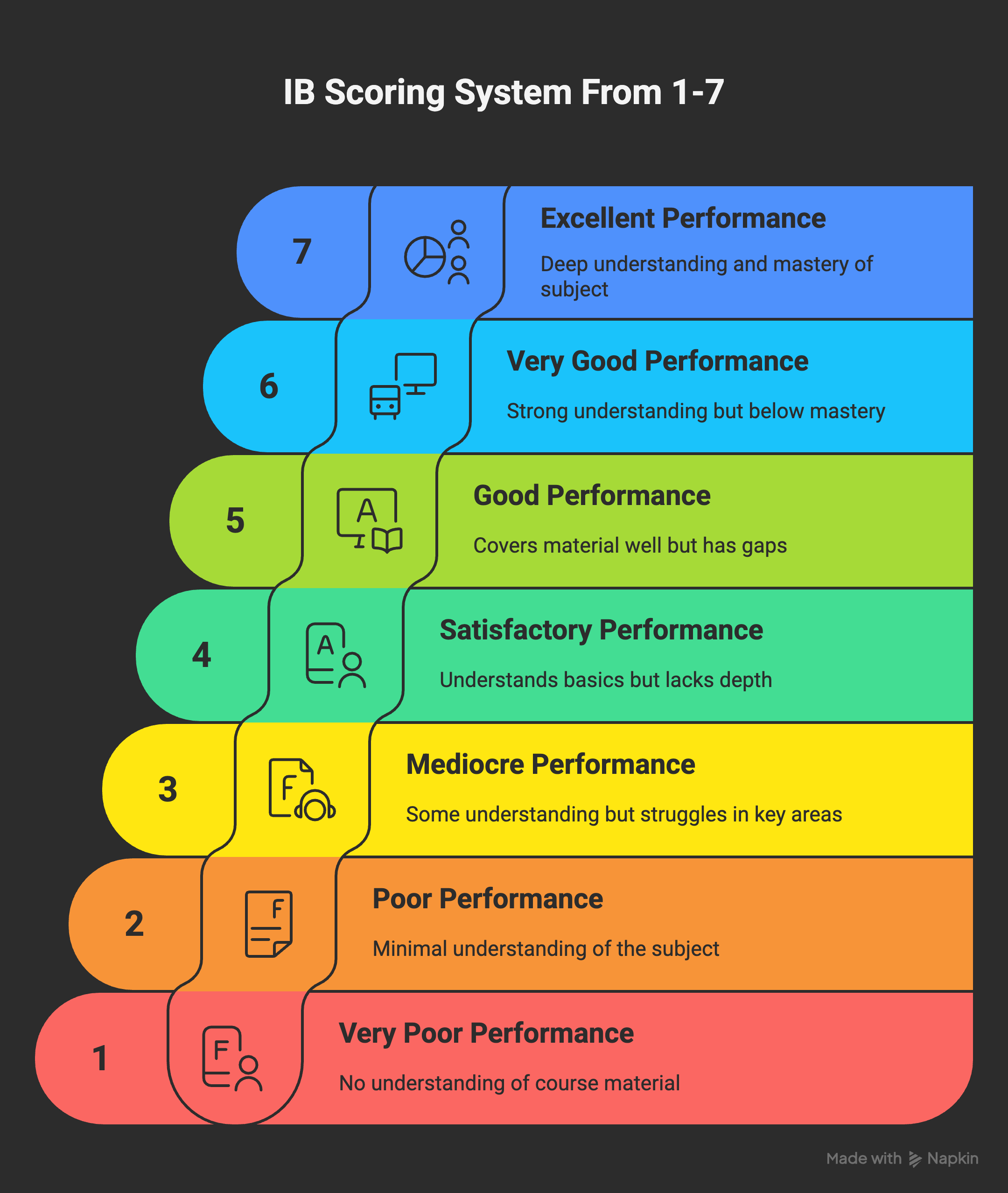KIS Summary:
- IB uses a 1-7 scoring scale across 6 subjects, totaling 42 points, with each subject's score based on Internal Assessments (IAs worth 20-30% depending on subject/level) and External Assessments (exams worth 70-80%).
- Theory of Knowledge (TOK) and Extended Essay (EE) contribute up to 3 bonus points: both graded A-E with combinations like A+A or A+B earning 3 points, B+B/A+C/B+C earning 2 points, C+C earning 1 point, while scoring E+E results in diploma failure regardless of other scores.
- TOK combines an exhibition (3 objects, 10 marks, 1/3 weight) and essay (10 marks, 2/3 weight) totaling 30 points; EE is a 4,000-word independent research project marked out of 34.
⭐️ Why Parents & Students Love KIS Tutoring
If you’re an IB student or parent trying to wrap your head around the IB program, understanding how it is graded is essential. From assessments to final scores, the IB grading system may seem complex, but it is crucial to know how it works so you can achieve the highest IB score.
In this blog, we will break down the IB grading process, from the 1-7 scoring to the additional points from Theory of Knowledge (TOK) and your Extended Essay (EE)!
Table Of Contents:
- How Does The IB Scoring System Work?
- What Contributes To Your Subject Score?
- How Does TOK And EE Work?
- How Does IB Work In Australia?
- Conclusion On How The IB Is Calculated And Graded
- FAQs About How The IB Is Calculated And Graded
How Does The IB Scoring System Work?
You may be used to seeing a letter (A, B, C, etc.) as your grade. However, the IB works a bit differently compared to other secondary school programs and uses a number scale from 1-7.
Every student takes 6 subjects (3 HL and 3 SL). The scoring for each subject may seem a bit arbitrary at first, but it’s based on subject-specific criteria that assess your understanding and mastery of the course content. This means you can achieve 42 points if you get 7s in all your subjects.
But isn’t the IB out of 45? Yes, you are correct! We’ll explore where the 3 additional points come from later!
Back to the scoring system. Let’s break it down:

The overall goal for most students is to achieve scores of 6 or 7. But what percentage score do you need to get a 7? This is a bit complicated as the IB uses a normal distribution curve to assign the scores. But a good estimate of a 7 or 6 can be found by looking at past grade boundaries that the IB publishes (these rarely change drastically from year to year).
What Contributes To Your IB Subject Scores?
Your score comes from multiple assessments. Normally, it's one IA (internal assessment) and your exams (external assessment). This is different with each subject and whether you are taking HL or SL. Let’s break it down for each subject group!
Group 1: Language and Literature
Subjects in this group include English Literature and English Language and Literature.
Internal Assessments:
- Both HL and SL must complete and Individual Oral (IO). For HL it contributes to 20% of the final grade. For SL it contributes to 30% of the final grade
- For HL, students must complete an essay based on one literary or non-literary body of work studied. This is worth 20% of the final grade
External Assessments:
- HL and SL must do a Paper 1. For HL and SL it is worth 35% of the final mark.
- HL and SL must also do a Paper 2. For HL it is worth 25% of the final mark, for SL it is worth 35% of the final mark
Group 2: Language Acquisition
Subjects in this group include foreign languages the student is not fluent in.
Internal Assessment:
- Both HL and SL students must complete and individual oral worth 25% of the final mark
External Assessment:
- Both HL and SL must complete a Paper 1 (Writing Paper), Paper 2 (Reading Paper) and a Listening Exam, with each being worth 25%
Group 3: Individuals and Societies
Subjects include History, Geography, Business Management, Economics and more.
For Internal Assessments and External Assessments, the weighting differs:
- Business’ IA is 25% of the final mark, while Economics’ IA is 30% of the final mark
- To find out the weighting refer to the IB website

Group 4: Sciences
These subjects include Biology, Chemistry, Physics and Health Science.
Internal Assessment:
- IA’s count for 20% and are marked out of 24
External Assessments:
- 80% stems from Paper 1 (Multiple Choice), Paper 2 (Data based and written exam) and Paper 3 (Questions relating to your Option)
Group 5: Mathematics
The weighting of internal and external assessments is the same throughout all.
Internal Assessment:
- All students must create a math exploration on a topic of their interest. It is marked out of 20 and contributes to 20% of their final grade
External Assessment:
- For SL, there are 2 papers which contribute to 80% of your grade
- For HL, there are 3 exams which contribute to 80% of your grade
How Does IB TOK And EE Work?
TOK and EE add up to 3 additional points towards your IB score. TOK and EE are both graded on a letter scale from E to A, with E being a fail, and A being excellent.
Here’s how the additional points work:
- A+A: 3 points
- A+B: 3 points
- A+C, B+B, B+C, A+D: 2 points
- C+C, C+D: 1 point
- C+D: 0 points
- E+E: Failing condition (you cannot receive the diploma if you score two Es)
1. What is TOK?
TOK is an interdisciplinary course that grades as an exhibition and essay. The exhibition is a mini essay that focuses on 3 objects (of your choice), whilst the essay answers one of the provided questions from the IB.
- The exhibition is out of 10 and is worth 1/3 of the final TOK score
- The essay is out of 10 and is worth 2/3 of the final TOK score
- A = 22 – 30
- B = 16 – 21
- C = 10 – 15
- D = 4 – 9
- E = 0 -3
- You can calculate this by adding your exhibition score to 2x your essay score
2. What is the EE?
The EE is an independent research project on a subject of your choice. You must choose an IB subject, formulate a research question, and evaluate this question using content that exceeds what is taught in the IB. The EE is out of 34.
- A = 27 – 34
- B = 21 – 26
- C = 14 – 20
- D = 7 – 13
- E = 0 – 6
How Does IB Work In Australia?
In Australia, the ATAR system is used to apply for universities. IBAS converts your IB score into an ATAR score.
Note that there are decimals; IBAS calculates these based on how far you are to grade boundaries in subjects. If you just scrape the grade boundaries, you will most likely have .25 at the end. If you are really close to the next grade boundary for subjects you will have .75 at the end.
Conclusion On How The IB Is Calculated And Graded
And that’s the IB Grading System! The IB grading system might seem complicated at first, but hopefully we made it clearer. If you want to maximise your score, contact KIS Academics for a tutoring session!
After more resources? Check these out!👇



FAQs About How The IB Is Calculated And Graded
1. How does the IB programme work?
You choose one subject from each of five groups, including two languages, social sciences, experimental sciences, and mathematics. You also choose either an arts subject from a sixth group, or another subject from groups one to five.
2. Is IB harder than ATAR?
The International Baccalaureate (IB) is often considered more difficult than the ATAR due to its broader curriculum, additional components like the Theory of Knowledge (TOK) and Extended Essay (EE), and a higher overall workload over a two year period.
3. How does the IB exam work?
Students are evaluated using both internal and external assessments, where subjects externally examined are considered final exams, usually consisting of two or three timed written tests. Internal assessment varies by subject but can be subject to oral presentations, practical work, or written work.
4. What is the IB equivalent of ATAR 95?
A 95 ATAR is generally equivalent to an IB score of around 39 to 39.5, depending on the specific conversion table used by the relevant university admissions centre.
For example, VTAC lists a 39 IB score as equivalent to a 95.75 ATAR, while the Universities Admissions Centre (UAC) shows a 39 IB score converting to a Combined Rank of 95.75.
5. How difficult is it to get a 45 IB score?
Getting a 45 on the IB is extremely difficult, as it is a flawless score achieved by fewer than 1–2% of students worldwide each year.
To achieve this, a student must score a perfect 7 in all six academic subjects and earn 3 bonus points from TOK and the EE by achieving an A in both.






